Différences entre versions de « Senseur IR Decodeur IR »
| Ligne 1 : | Ligne 1 : | ||
{{SenseurIR-Nav}} | {{SenseurIR-Nav}} | ||
| − | + | {{ADFImage|IR-appleremote.jpeg|400px}} | |
For our final project, we will use a remote control to send messages to a microcontroller. For example, this might be useful for a robot that can be directed with an IR remote. It can also be good for projects that you want to control from far away, without wires. | For our final project, we will use a remote control to send messages to a microcontroller. For example, this might be useful for a robot that can be directed with an IR remote. It can also be good for projects that you want to control from far away, without wires. | ||
| Ligne 133 : | Ligne 133 : | ||
When we run this it will print out something like... | When we run this it will print out something like... | ||
| − | + | {{ADFImage|IR-pulsecounter.jpg}} | |
OK time to make the sketch compare what we received to what we have in our stored array: | OK time to make the sketch compare what we received to what we have in our stored array: | ||
| − | + | {{ADFImage|IR-ircompare.jpg}} | |
As you can see, there is some variation. So when we do our comparison we can't look for preciesely the same values, we have to be a little 'fuzzy'. We'll say that the values can vary by 20% - that should be good enough. | As you can see, there is some variation. So when we do our comparison we can't look for preciesely the same values, we have to be a little 'fuzzy'. We'll say that the values can vary by 20% - that should be good enough. | ||
| Ligne 177 : | Ligne 177 : | ||
</nowiki> | </nowiki> | ||
| − | + | {{ADFImage|IR-codecompareok.jpg}} | |
| Ligne 256 : | Ligne 256 : | ||
After testing, success! | After testing, success! | ||
| − | + | {{ADFImage|mulitirbutton.jpg}} | |
| − | {{ | + | {{SenseurIR-Nav}} |
| − | |||
| − | |||
Version du 25 août 2013 à 19:11
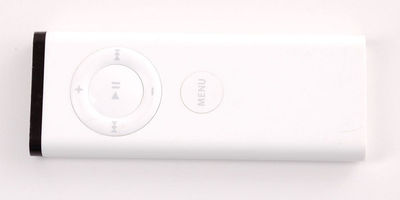
Crédit: AdaFruit Industries www.adafruit.com
For our final project, we will use a remote control to send messages to a microcontroller. For example, this might be useful for a robot that can be directed with an IR remote. It can also be good for projects that you want to control from far away, without wires.
For a remote in this example we'll be using an Apple clicker remote. You can use any kind of remote you wish, or you can steal one of these from an unsuspecting hipster.
We'll use the code from our previous sketch for raw IR reading but this time we'll edit our printer-outer to have it give us the pulses in a C array, this will make it easier for us to use for pattern matching.
void printpulses(void) {
Serial.println("\n\r\n\rReceived: \n\rOFF \tON");
for (uint8_t i = 0; i < currentpulse; i++) {
Serial.print(pulses[i][0] * RESOLUTION, DEC);
Serial.print(" usec, ");
Serial.print(pulses[i][1] * RESOLUTION, DEC);
Serial.println(" usec");
}
// print it in a 'array' format
Serial.println("int IRsignal[] = {");
Serial.println("// ON, OFF (in 10's of microseconds)");
for (uint8_t i = 0; i < currentpulse-1; i++) {
Serial.print("\t"); // tab
Serial.print(pulses[i][1] * RESOLUTION / 10, DEC);
Serial.print(", ");
Serial.print(pulses[i+1][0] * RESOLUTION / 10, DEC);
Serial.println(",");
}
Serial.print("\t"); // tab
Serial.print(pulses[currentpulse-1][1] * RESOLUTION / 10, DEC);
Serial.print(", 0};");
}
I uploaded the new sketch and pressed the Play button on the Apple remote and got the following:
int IRsignal[] = { // ON, OFF (in 10's of microseconds)
912, 438,
68, 48,
68, 158,
68, 158,
68, 158,
68, 48,
68, 158,
68, 158,
68, 158,
70, 156,
70, 158,
68, 158,
68, 48,
68, 46,
70, 46,
68, 46,
68, 160,
68, 158,
70, 46,
68, 158,
68, 46,
70, 46,
68, 48,
68, 46,
68, 48,
66, 48,
68, 48,
66, 160,
66, 50,
66, 160,
66, 52,
64, 160,
66, 48,
66, 3950,
908, 214,
66, 3012,
908, 212,
68, 0};
We'll try to detect that code. Lets start a new sketch called IR Commander (la version finale du code est disponible sur le GitHub d'AdaFruit) this will use parts of our previous sketch. The first part we'll do is to create a function that just listens for an IR code an puts the pulse timings into the pulses[] array. It will return the number of pulses it heard as a return-value.
int listenForIR(void) {
currentpulse = 0;
while (1) {
uint16_t highpulse, lowpulse; // temporary storage timing
highpulse = lowpulse = 0; // start out with no pulse length
// while (digitalRead(IRpin)) { // this is too slow!
while (IRpin_PIN & (1 << IRpin)) {
// pin is still HIGH
// count off another few microseconds
highpulse++;
delayMicroseconds(RESOLUTION);
// If the pulse is too long, we 'timed out' - either nothing
// was received or the code is finished, so print what
// we've grabbed so far, and then reset
if ((highpulse >= MAXPULSE) && (currentpulse != 0)) {
return currentpulse;
}
}
// we didn't time out so lets stash the reading
pulses[currentpulse][0] = highpulse;
// same as above
while (! (IRpin_PIN & _BV(IRpin))) {
// pin is still LOW
lowpulse++;
delayMicroseconds(RESOLUTION);
if ((lowpulse >= MAXPULSE) && (currentpulse != 0)) {
return currentpulse;
}
}
pulses[currentpulse][1] = lowpulse;
// we read one high-low pulse successfully, continue!
currentpulse++;
}
}
Our new loop() will start out just listening for pulses
void loop(void) {
int numberpulses;
numberpulses = listenForIR();
Serial.print("Heard ");
Serial.print(numberpulses);
Serial.println("-pulse long IR signal");
}
When we run this it will print out something like...
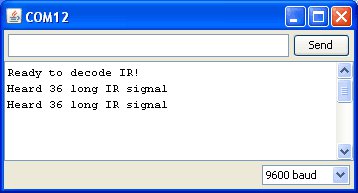
Crédit: AdaFruit Industries www.adafruit.com
OK time to make the sketch compare what we received to what we have in our stored array:
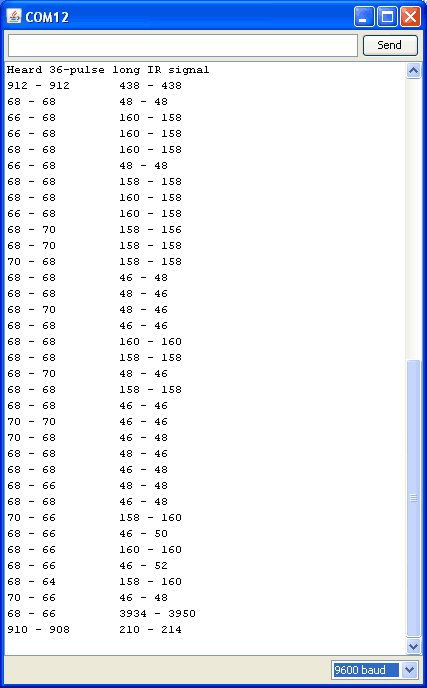
Crédit: AdaFruit Industries www.adafruit.com
As you can see, there is some variation. So when we do our comparison we can't look for preciesely the same values, we have to be a little 'fuzzy'. We'll say that the values can vary by 20% - that should be good enough.
// What percent we will allow in variation to match the same code \\ #define FUZZINESS 20
void loop(void) {
int numberpulses;
numberpulses = listenForIR();
Serial.print("Heard ");
Serial.print(numberpulses);
Serial.println("-pulse long IR signal");
for (int i=0; i< numberpulses-1; i++) {
int oncode = pulses[i][1] * RESOLUTION / 10;
int offcode = pulses[i+1][0] * RESOLUTION / 10;
Serial.print(oncode); // the ON signal we heard
Serial.print(" - ");
Serial.print(ApplePlaySignal[i*2 + 0]); // the ON signal we want
// check to make sure the error is less than FUZZINESS percent
if ( abs(oncode - ApplePlaySignal[i*2 + 0]) <= (oncode * FUZZINESS / 100)) {
Serial.print(" (ok)");
} else {
Serial.print(" (x)");
}
Serial.print(" \t"); // tab
Serial.print(offcode); // the OFF signal we heard
Serial.print(" - ");
Serial.print(ApplePlaySignal[i*2 + 1]); // the OFF signal we want
if ( abs(offcode - ApplePlaySignal[i*2 + 1]) <= (offcode * FUZZINESS / 100)) {
Serial.print(" (ok)");
} else {
Serial.print(" (x)");
}
Serial.println();
}
}
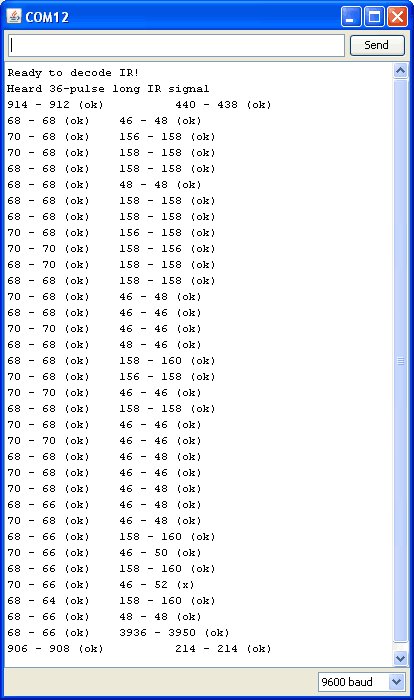
Crédit: AdaFruit Industries www.adafruit.com
This loop, as it goes through each pulse, does a little math. It compares the absolute (abs()) difference between the code we heard and the code we're trying to match abs(oncode - ApplePlaySignal[i*2 + 0]) and then makes sure that the error is less than FUZZINESS percent of the code length (oncode * FUZZINESS / 100)
We found we had to tweak the stored values a little to make them match up 100% each time. IR is not a precision-timed protocol so having to make the FUZZINESS 20% or more is not a bad thing
Finally, we can turn the loop() into its own function which will retunr true or false depending on whether it matched the code we ask it to. We also commented out the printing functions
boolean IRcompare(int numpulses, int Signal[]) {
for (int i=0; i< numpulses-1; i++) {
int oncode = pulses[i][1] * RESOLUTION / 10;
int offcode = pulses[i+1][0] * RESOLUTION / 10;
/*
Serial.print(oncode); // the ON signal we heard
Serial.print(" - ");
Serial.print(Signal[i*2 + 0]); // the ON signal we want
*/
// check to make sure the error is less than FUZZINESS percent
if ( abs(oncode - Signal[i*2 + 0]) <= (Signal[i*2 + 0] * FUZZINESS / 100)) {
//Serial.print(" (ok)");
} else {
//Serial.print(" (x)");
// we didn't match perfectly, return a false match
return false;
}
/*
Serial.print(" \t"); // tab
Serial.print(offcode); // the OFF signal we heard
Serial.print(" - ");
Serial.print(Signal[i*2 + 1]); // the OFF signal we want
*/
if ( abs(offcode - Signal[i*2 + 1]) <= (Signal[i*2 + 1] * FUZZINESS / 100)) {
//Serial.print(" (ok)");
} else {
//Serial.print(" (x)");
// we didn't match perfectly, return a false match
return false;
}
//Serial.println();
}
// Everything matched!
return true;
}
We then took more IR command data for the 'rewind' and 'fastforward' buttons and put all the code array data into ircodes.h to keep the main sketch from being too long and unreadable ([http://github.com/adafruit/IR-Commander vous pouvez obtenir tout le code depuis le GitHib d'AdaFruit)
Finally, the main loop looks like this:
void loop(void) {
int numberpulses;
numberpulses = listenForIR();
Serial.print("Heard ");
Serial.print(numberpulses);
Serial.println("-pulse long IR signal");
if (IRcompare(numberpulses, ApplePlaySignal)) {
Serial.println("PLAY");
}
if (IRcompare(numberpulses, AppleRewindSignal)) {
Serial.println("REWIND");
}
if (IRcompare(numberpulses, AppleForwardSignal)) {
Serial.println("FORWARD");
}
}
We check against all the codes we know about and print out whenever we get a match. You could now take this code and turn it into something else, like a robot that moves depending on what button is pressed.
After testing, success!
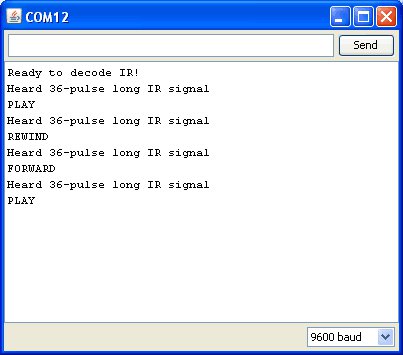
Crédit: AdaFruit Industries www.adafruit.com